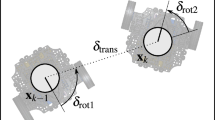Abstract
Conventional localization methods have been developed for indoor static environments such as the home environment. In dynamic environments such as factories and warehouses, however, it is difficult to estimate the accurate robot pose. Therefore, we propose a novel approach for the estimation of the robot pose in a dynamic or large environment for which fixed features are used. In the proposed method, a ceiling-feature map is built using an upward-looking monocular camera. This map is created accurately from the robot pose using a laser scanner and an estimation based on the iterative closest point method. The ceiling-feature map consists of features such as lamps and the FREAK, and its creation can be more accurate if the sliding-window technique and bundle-adjustment schemes are used. During the post-mapping navigation, the robot pose is estimated using the Monte Carlo localization method based on the ceiling-feature map. In dynamic experiments, the proposed method shows a high repeatability and stability in real-world conditions and applications.




















Similar content being viewed by others
Explore related subjects
Discover the latest articles, news and stories from top researchers in related subjects.References
Liu M, Pradalier C, Siegwart R (2013) Visual Homing from Scale with an uncalibrated omnidirectional camera. IEEE Trans Robot 29(6):1353–1365
Qiu K, Zhang F, Liu M (2015) Visible light communication-based indoor localization using Gaussian Process. In: Proceedings of the IEEE/RSJ international conference on intelligent robots and systems
Hwang SY, Song JB (2013) Clustering and probabilistic matching of arbitrarily shaped ceiling features for monocular vision-based SLAM. IEEE Trans Adv Robot 27(10):739–747
Montemerlo M, Thrun S, Koller D, and Wegbreit B (2003) FastSLAM 2.0: an improved particle filtering algorithm for simultaneous localization and mapping that provably converges. In: Proceedings of the 16th international joint conference on artificial intelligence
Fox D, Bugard W, Thrun S (1998) Active Markov localization for mobile robots. IEEE Trans Robot Auton Syst 25:195–207
Beccari G, Caselli S, Zanichelli F, Calafiore A (1997) Vision based line tracking and navigation in structured environments. IEEE international symposium on computational intelligent in robotics and automation, pp 406–411
Ronzoni D, Olmi R, Secchi C, Fantuzzi C (2011) AGV global localization using indistinguishable artificial landmarks. In: Proceedings of the IEEE international conference on robotics and automation, pp. 287–292
Rusinkiewicz R, Levoy M (2001) Efficient variants of the ICP algorithm. International conference on 3D digital imaging and modeling, pp 145–153
Pomerleau F, Magnenat S, Colas F, Liu M, Siegwart R (2011) Tracking a depth camera: parameter exploration for fast ICP. In: Proceedings of the IEEE/RSJ international conference on intelligent robots and systems
Alahi A, Ortiz R, Vandergheynst P (2012) Freak: fast retina keypoint. In: Proceedings of the IEEE international conference on computer vision and pattern recognition (CVPR), pp 510–517
Hansen P, Alismail H, Rander P, Browning B (2012) Online continuous stereo extrinsic parameter estimation. In: Proceedings of the IEEE international conference on computer vision and pattern recognition, pp 1059–1066
Donoser M, Bischof H (2006) Efficient maximally stable extremal region (MSER) tracking. In: Proceedings of conference on computer vision and pattern recognition, pp 553–560
Zhang Z, Deriche R, Faugeras O, Luong QT (1995) A robust technique for matching two uncalibrated images through the recovery of the unknown epipolar geometry. IEEE Trans Artif Intell 78(1):87–119
Kukelova Z, Heller J, Bujnak M, Fitzgibbon A, Pajdla T (2015) Efficient solution to the epipolar geometry for radially distorted cameras. In: Proceedings of the IEEE international conference on computer vision, pp 2309–2317
Houssineau J, Clark DE, Ivekovic S, Lee CS, Franco J (2016) A unified approach for multi-object triangulation, tracking and camera calibration. IEEE Trans Signal Process 64(11):2934–2948
Triggs B, McLauchlan PF, Hartley RI, Fitzgibbon AW (2000) Bundle adjustment—a modern synthesis. IEEE transactions on in vision algorithms: theory and practice, pp 298–372
Moré JJ (1978) The Levenberg–Marquardt algorithm: implementation and theory. IEEE transactions on numerical analysis, pp 105–116
Wang Z, Bovik AC (2002) A universal image quality index. IEEE Trans Signal Process Lett 9(3):81–84
Author information
Authors and Affiliations
Corresponding author
Rights and permissions
About this article
Cite this article
Jung, M., Song, JB. Robust mapping and localization in indoor environments. Intel Serv Robotics 10, 55–66 (2017). https://doi.org/10.1007/s11370-016-0209-2
Published:
Issue Date:
DOI: https://doi.org/10.1007/s11370-016-0209-2




